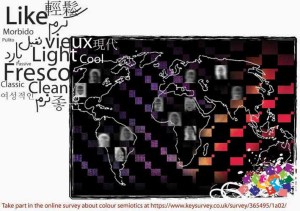Monica D.Murgia who teaches art in the United states of America, arranged an interview with me on her blog. She has some questions about colour semiotics and the reasons of my interset, also about my survey.
Visit the weblink below to see my answers
Monica D.Murgia who teaches art in the United states of America, arranged an interview with me on her blog. She has some questions about colour semiotics and the reasons of my interset, also about my survey.
Visit the weblink below to see my answers
 Ever wandered about colour?Ever had certain feelings for a colour?Ever noticed the diversity of opinions upon colours amongst different personalities and cultures?
Ever wandered about colour?Ever had certain feelings for a colour?Ever noticed the diversity of opinions upon colours amongst different personalities and cultures?
If your answer is yes, then I am proud to say that you are interested in colour semiotics. Colour semiotics starts from the very early stages of symbolization. From where we used to assess danger with red and safety with green, but this was only the beginning of the story as for colour semiotics, later entered the complex world of design. Nowadays, knowledge upon colour semiotics can lead to successful marketing, branding, advertising and etc.
But how can we access a firm knowledge on this broad aspect of colour which has no ends, as it depends on so many factors. Well, I am proud to say that there has been much academic research upon this fact and there are many articles which you can get hold of. Still, there are not many clear models which you can use, again; because of the high number of factors involved. Precise framework leads to successful colour selection which is not limited to certain artists or designers.
Hereby, a PhD study sounds perfect; using modelling and programming skills for generating a framework for early designers or artists who wish to take a professional step forward without any hassle.
First step is to know how people think about certain colours, is it heavy or light? Soft or hard? … Then this relation with each colour would be modelled (with all the parameters acknowledged such as age, gender, native language and etc.) and programmed so that it would turn in to a tool for ease of use.
The global online colour semiotic survey is specially designed for this purpose, distributed all over the world to consider as much diversity as possible. The novelty of this method is that; instead of asking lots of questions about lots of colours, we just present one colour chosen from a set of colours to each obserevr. By raising the number of participants we would eventually collect response on all colours of the selected range. And by this, not only more response is collected but the accuracy is higher as respondents would only be focusing on one colour.
If you would like to get informed about the results, you can simple subscribe to the e-mailing list on the right hand side menu.